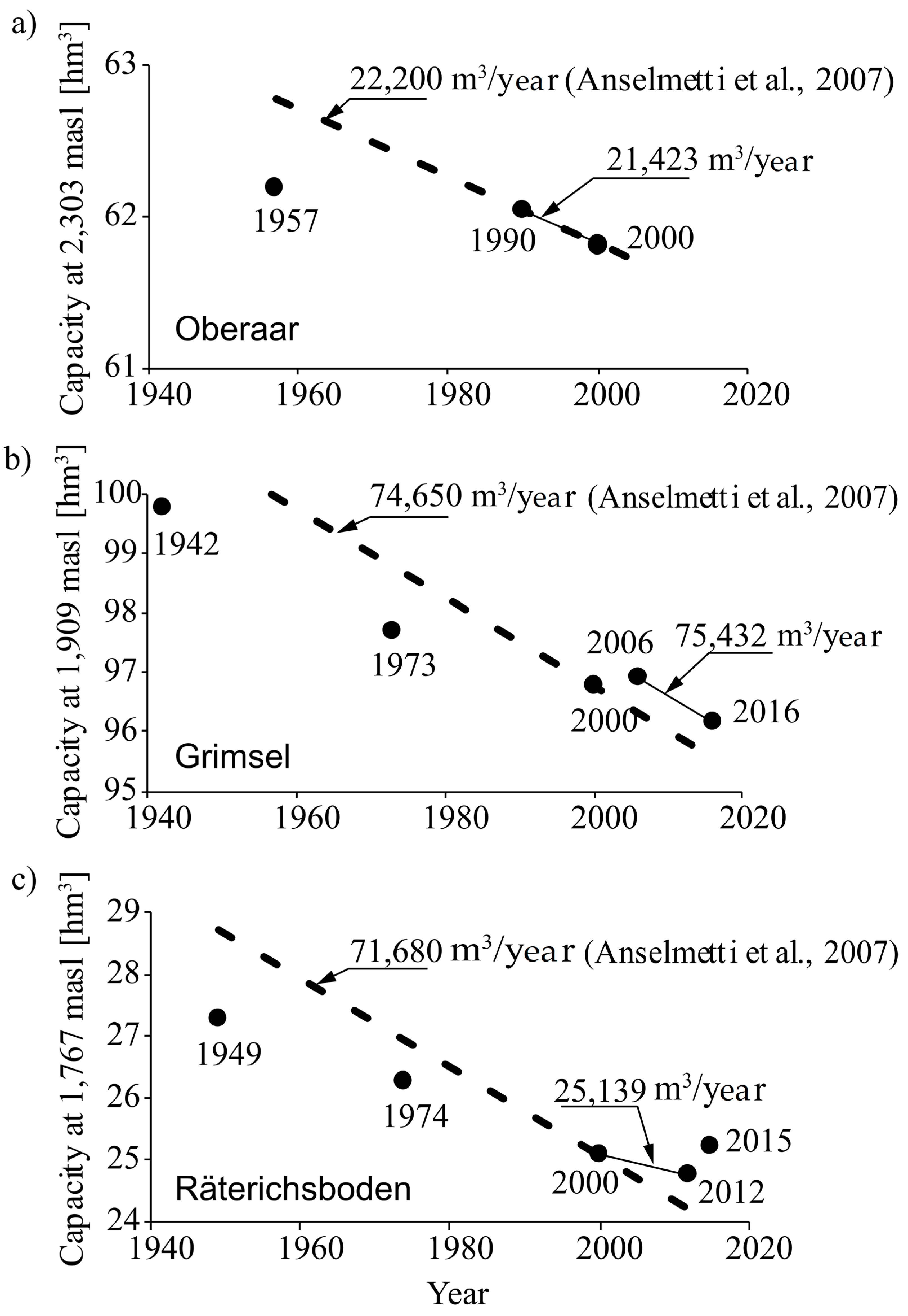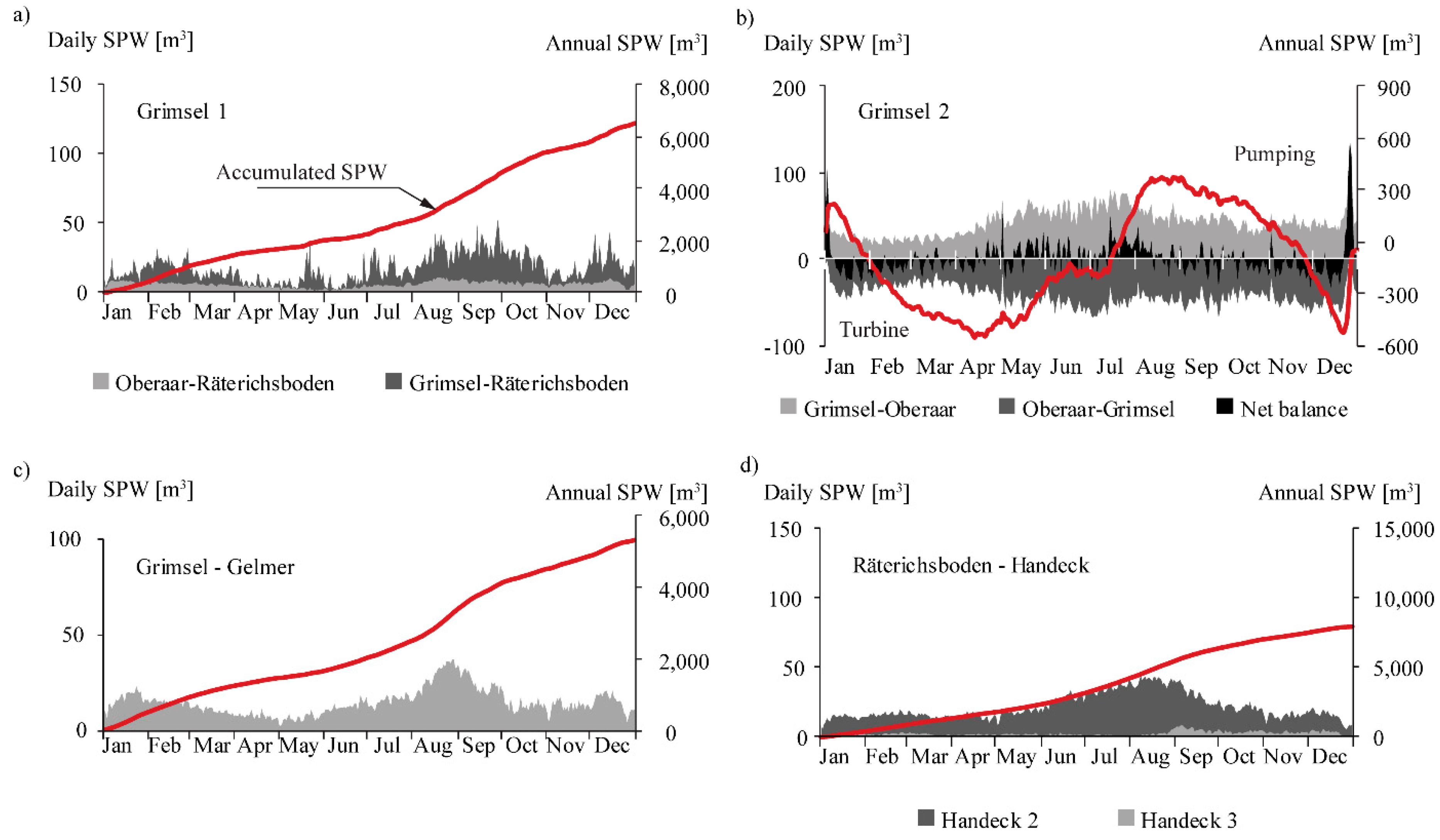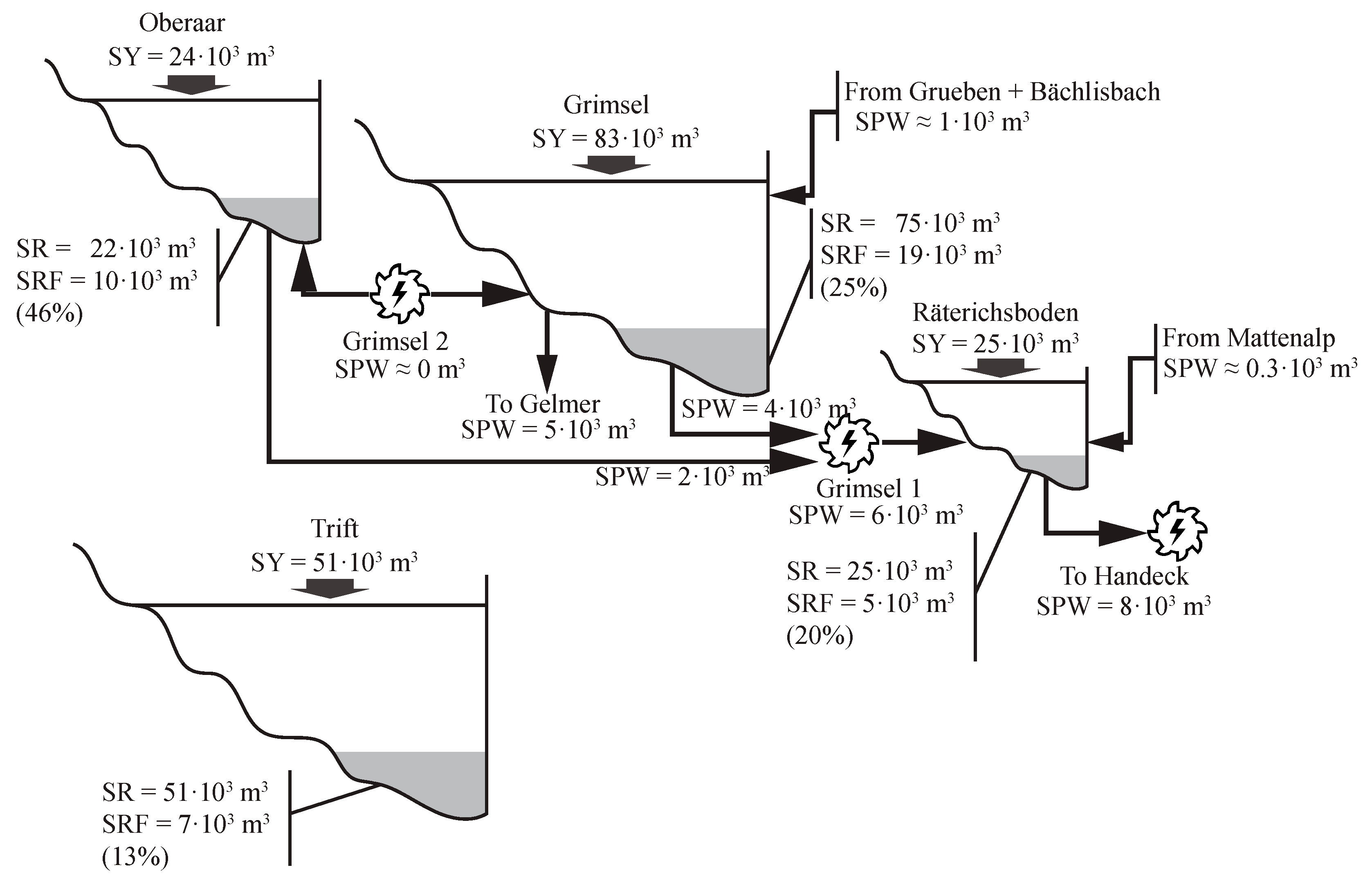Multidecadal Sediment Balance Modelling of a Cascade of Alpine Reservoirs and Perspectives Based on Climate Warming
Abstract
:1. Introduction
- Characterize the present sediment balance of a complex hydropower cascade, by quantifying and modelling the annual sediment inputs and outputs and determining the sedimentation rate of each reservoir.
- Estimate the effects of climate warming on the sediment dynamics of the catchments and assess the future evolution of sediment trapping in the reservoirs by means of the previously established model.
2. Case Study
3. Methodology
3.1. Sediment Yield
- Period I, from 1990 to 2012, for which the parameters are characterized by field measurements.
- Period II, from 2013 to 2065, and Period III, from 2066 to 2099, for which the parameters are characterized by the predictions based on the A1B climate change scenario [22].
3.2. Sedimentation Rate
3.3. Sedimentation Rate for Fine Sediments
3.4. Sedimentation Exchange through Power Waterways
4. Results
4.1. Sediment Yield
4.2. Sedimentation Rate
4.3. Sedimentation Rate of Fine Sediments
4.4. Sediment Fluxes through the Power Waterways
4.5. Sediment Balance at Present
5. Discussion
5.1. Present Situation
5.2. Perspectives Based on Climate Warming
6. Conclusions
Author Contributions
Funding
Acknowledgments
Conflicts of Interest
References
- Morris, G.L.; Fan, J. Reservoir Sedimentation Handbook: Design and Management of Dams, Reservoirs, and Watersheds for Sustainable Use; McGraw-Hill Book Co.: New York, NY, USA, 1998. [Google Scholar]
- Basson, G.R. Management of siltation in existing and new reservoirs. General Report Q. 89. In Proceedings of the 23rd Congress of the International Commission on Large Dams CIGB-ICOLD, Brasilia, Brazil, 25–29 May 2009; Volume 2. [Google Scholar]
- Rahmani, V.; Kastens, J.; De Noyelles, F.; Jakubauskas, M.; Martinko, E.; Huggins, D.; Gnau, C.; Liechti, P.; Campbell, S.; Callihan, R.; et al. Examining Storage Capacity Loss and Sedimentation Rate of Large Reservoirs in the Central U.S. Great Plains. Water 2018, 10, 190. [Google Scholar] [CrossRef]
- Schleiss, A.J.; Franca, M.J.; Juez, C.; De Cesare, G. Reservoir sedimentation. J. Hydraul. Res. 2016, 54, 595–614. [Google Scholar] [CrossRef]
- Kondolf, G.M.; Rubin, Z.K.; Minear, J.T. Dams on the Mekong: Cumulative sediment starvation. Water Resour. Res. 2014, 50, 5158–5169. [Google Scholar] [CrossRef] [Green Version]
- Finger, D.; Schmid, M.; Wüest, A. Effects of upstream hydropower operation on riverine particle transport and turbidity in downstream lakes. Water Resour. Res. 2006, 42. [Google Scholar] [CrossRef] [Green Version]
- Bonalumi, M.; Anselmetti, F.S.; Kaegi, R.; Wüest, A. Particle dynamics in high-Alpine proglacial reservoirs modified by pumped-storage operation. Water Resour. Res. 2011, 47. [Google Scholar] [CrossRef] [Green Version]
- Liu, C.; Walling, D.E.; He, Y. Review: The International Sediment Initiative case studies of sediment problems in river basins and their management. Int. J. Sediment Res. 2018, 33, 216–219. [Google Scholar] [CrossRef]
- Ali, Y.S.A.; Crosato, A.; Mohamed, Y.A.; Abdalla, S.H.; Wright, N.G. Sediment balances in the Blue Nile River Basin. Int. J. Sediment Res. 2014, 29, 316–328. [Google Scholar] [CrossRef]
- Aas, E.; Bogen, J. Colors of glacier water. Water Resour. Res. 1988, 24, 561–565. [Google Scholar] [CrossRef]
- Anselmetti, F.S.; Bühler, R.; Finger, D.; Girardclos, S.; Lancini, A.; Rellstab, C.; Sturm, M. Effects of Alpine hydropower dams on particle transport and lacustrine sedimentation. Aquat. Sci. 2007, 69, 179–198. [Google Scholar] [CrossRef]
- Costa, A.; Molnar, P.; Stutenbecker, L.; Bakker, M.; Silva, T.A.; Schlunegger, F.; Lane, S.N.; Loizeau, J.-L.; Girardclos, S. Temperature signal in suspended sediment export from an Alpine catchment. Hydrol. Earth Syst. Sci. Discuss. 2017, 1–30. [Google Scholar] [CrossRef]
- Hinderer, M.; Kastowski, M.; Kamelger, A.; Bartolini, C.; Schlunegger, F. River loads and modern denudation of the Alps—A review. Earth Sci. Rev. 2013, 118, 11–44. [Google Scholar] [CrossRef]
- Chamoun, S.; De Cesare, G.; Schleiss, A.J. Venting turbidity currents for the sustainable use of reservoirs. Int. J. Hydropower Dams 2016, 23, 64–69. [Google Scholar]
- Alavian, V.; Jirka, G.H.; Denton, R.A.; Johnson, M.C.; Stefan, H.G. Density Currents Entering Lakes and Reservoirs. J. Hydraul. Eng. 1992, 118, 1464–1489. [Google Scholar] [CrossRef]
- Boes, R.; Auel, C.; Hagmann, M.; Albayrak, I. Sediment bypass tunnels to mitigate reservoir sedimentation and restore sediment continuity. In Reservoir Sedimentation; Schleiss, A.J., De Cesare, G., Franca, M.J., Pfister, M., Eds.; CRC Press: Lausanne, Switzerland, 2014; pp. 221–228. ISBN 9781138026759. [Google Scholar]
- Müller, M.; De Cesare, G.; Schleiss, A.J. Continuous Long-Term Observation of Suspended Sediment Transport between Two Pumped-Storage Reservoirs. J. Hydraul. Eng. 2014, 140, 05014003. [Google Scholar] [CrossRef] [Green Version]
- Haeberli, W.; Bütler, M.; Huggel, C.; Müller, H.; Schleiss, A. Formation des nouveaux lacs suite au recul des glaciers en haute montagne – chances et risques. Forschungsbericht des Nationalen Forschungsprogramms 2013, 61, 159–190. [Google Scholar] [CrossRef]
- Beyer Portner, N. Erosion des Bassins Versants Alpins par Ruissellement de Surface, Communication 6; École Polytechnique Fédérale de Lausanne EPFL: Lausanne, Switzerland, 1998. [Google Scholar]
- Wischmeier, W.H.; Smith, D.D. Predicting Rainfall Erosion Losses—A Guide to Conservation Planning; U.S. Department of Agriculture: Washington, DC, USA, 1978.
- Gavrilovic, Z. Use of an Empirical Method (Erosion Potential Method) for Calculating Sediment Production and Transportation in Unstudied or Torrential Streams. In Proceedings of the International Conference on River Regime, Wallingford, UK, 18–20 May 1988; Hydraulic Research Limited: Wallingford, UK, 1988; pp. 411–422. [Google Scholar]
- Appenzeller, C.; Bey, I.; Croci Maspoli, M.; Fuhrer, J.; Knutti, R.; Kull, C.; Schär, C. Swiss Climate Change Scenarios CH2011; C2SM, Meteo Swiss, ETH, NCCR Climate, OcCC: Zürich, Switzerland, 2011; ISBN 9783033030657. [Google Scholar]
- van der Linden, P.; Mitchell, J.F.B. ENSEMBLES: Climate Change and Its Impacts—Summary of Research and Results from the ENSEMBLES Project; Met Office Hadley Centre: Exeter, UK, 2009. [Google Scholar]
- Ivanov, M.A.; Kotlarski, S. Assessing distribution-based climate model bias correction methods over an alpine domain: Added value and limitations. Int. J. Climatol. 2017, 37, 2633–2653. [Google Scholar] [CrossRef]
- Kotlarski, S.; Ivanov, M.; Schär, C. Bias-Corrected Transient Scenarios at the Local Scale and at Daily Resolution; CH2011 Extension series; OcCC: Zürich, Switzerland, 2017. [Google Scholar]
- Huss, M.; Farinotti, D.; Bauder, A.; Funk, M. Modelling runoff from highly glacierized alpine drainage basins in a changing climate. Hydrol. Processes 2008, 22, 3888–3902. [Google Scholar] [CrossRef]
- Farinotti, D.; Usselmann, S.; Huss, M.; Bauder, A.; Funk, M. Runoff evolution in the Swiss Alps: Projections for selected high-alpine catchments based on ENSEMBLES scenarios. Hydrol. Processes 2012, 26, 1909–1924. [Google Scholar] [CrossRef]
- Van Rijn, L.C. Sediment Transport, Part II: Suspended Load Transport. J. Hydraul. Eng. 1984, 110, 1613–1641. [Google Scholar] [CrossRef]
- Bonalumi, M. Effect of Pumped-Storage Operations on Temperature, Turbidity and Sedimentation in Reservoirs and possible Mitigation Measures. Ph.D. Thesis, ETH Zurich, Zürich, Switzerland, 2012. [Google Scholar]
- Kraftwerke Oberhasli AG; (Wasserhaushalt der KWO 1997–2015). Internal communication, Unpublished work. 2018.
- Schlatter, A.; Schneider, D.; Geiger, A.; Kahle, H.-G. Recent vertical movements from precise levelling in the vicinity of the city of Basel, Switzerland. Int. J. Earth Sci. 2005, 94, 507–514. [Google Scholar] [CrossRef]
- Einsele, G.; Hinderer, M. Terrestrial sediment yield and the lifetimes of reservoirs, lakes, and larger basins. Geol. Rundsch. 1997, 86, 288–310. [Google Scholar] [CrossRef]
- Einsele, G.; Hinderer, M. Quantifying denudation and sediment-accumulation systems (open and closed lakes): Basic concepts and first results. Palaeogeogr. Palaeoclimatol. Palaeoecol. 1998, 140, 7–21. [Google Scholar] [CrossRef]
- Hinderer, M. Late Quaternary denudation of the Alps, valley and lake fillings and modern river loads. Geodin. Acta 2001, 14, 231–263. [Google Scholar] [CrossRef]
- Lane, S.N.; Bakker, M.; Gabbud, C.; Micheletti, N.; Saugy, J.-N. Sediment export, transient landscape response and catchment-scale connectivity following rapid climate warming and Alpine glacier recession. Geomorphology 2017, 277, 210–227. [Google Scholar] [CrossRef]
- Hay, W.W. Detrital sediment fluxes from continents to oceans. Chem. Geol. 1998, 145, 287–323. [Google Scholar] [CrossRef]
- Milliman, J.D.; Syvitski, J.P.M. Geomorphic/Tectonic Control of Sediment Discharge to the Ocean: The Importance of Small Mountainous Rivers. J. Geol. 1992, 100, 525–544. [Google Scholar] [CrossRef]
- Micheletti, N.; Lane, S.N. Water yield and sediment export in small, partially glaciated Alpine watersheds in a warming climate. Water Resour. Res. 2016, 52, 4924–4943. [Google Scholar] [CrossRef]
- Raymond Pralong, M.; Turowski, J.M.; Rickenmann, D.; Zappa, M. Climate change impacts on bedload transport in alpine drainage basins with hydropower exploitation. Earth Surf. Processes Landf. 2015, 40, 1587–1599. [Google Scholar] [CrossRef]
- Zhou, Y.; Xu, Y.; Xiao, W.; Wang, J.; Huang, Y.; Yang, H. Climate Change Impacts on Flow and Suspended Sediment Yield in Headwaters of High-Latitude Regions—A Case Study in China’s Far Northeast. Water 2017, 9, 966. [Google Scholar] [CrossRef]
- Schaefli, B.; Manso, P.; Fischer, M.; Huss, M.; Farinotti, D. The role of glacier retreat for Swiss hydropower production. Renew. Energy 2018. [Google Scholar] [CrossRef]
- Serquet, G.; Marty, C.; Dulex, J.-P.; Rebetez, M. Seasonal trends and temperature dependence of the snowfall/precipitation-day ratio in Switzerland. Geophys. Res. Lett. 2011, 38. [Google Scholar] [CrossRef] [Green Version]
- Li, T.; Gao, Y. Runoff and Sediment Yield Variations in Response to Precipitation Changes: A Case Study of Xichuan Watershed in the Loess Plateau, China. Water 2015, 7, 5638–5656. [Google Scholar] [CrossRef] [Green Version]
- Müller, M.; De Cesare, G.; Schleiss, A.J. Experiments on the effect of inflow and outflow sequences on suspended sediment exchange rates. Int. J. Sediment Res. 2017, 32, 155–170. [Google Scholar] [CrossRef] [Green Version]
- Jenzer Althaus, J.M.I.; De Cesare, G.; Schleiss, A.J. Sediment Evacuation from Reservoirs through Intakes by Jet-Induced Flow. J. Hydraul. Eng. 2015, 141, 04014078. [Google Scholar] [CrossRef] [Green Version]
- Amini, A.; Manso, P.A.; Venuleo, S.; Lindsay, N.; Leupi, C.; Schleiss, A.J. Computational hydraulic modelling of fine sediment stirring and evacuation through the power waterways at the Trift reservoir. In Shaping the Future of Hydropower; Aqua Media International Ltd.: Seville, Spain, 2017. [Google Scholar]
- Guillén-Ludeña, S.; Manso, P.A.; Schleiss, A.J. Fine sediment routing in a cascade of alpine reservoirs: Influence of the inlet angle on settling of fine sediments. In Shaping the Future of Hydropower; Aqua Media International Ltd.: Seville, Spain, 2017. [Google Scholar]







| Characteristics of the Catchments | Oberaar | Grimsel | Räterichsboden | Trift (*) |
|---|---|---|---|---|
| Surface (km2) | 19.24 | 77.56 | 11.51 | 33.52 |
| Max altitude (m a.s.l.) | 3622 | 4262 | 3237 | 3486 |
| Mean altitude (m a.s.l.) | 2729 | 2669 | 2426 | 2667 |
| Min altitude (m a.s.l.) | 2209 | 1800 | 1650 | 1652 |
| Glaciated area in 2012 (%) | 29 | 35 | 0 | 46 |
| Maximum supply level (m a.s.l.) | 2303 | 1909 | 1767 | 1767 |
| Maximum capacity (hm3) | 62 | 97 | 25 | 85 |
| Lake surface (km2) | 1.60 | 2.82 | 0.65 | 1.10 |
| Catchment | Period I | Period II | Period III | |||
|---|---|---|---|---|---|---|
| VA | SY | VA | SY | VA | SY | |
| (m³·km−2·year−1) | (m³/year) | (m³·km−2·year−1) | (m³/year) | (m³·km−2·year−1) | (m³/year) | |
| Oberaar | 1262 | 24,276 | 1427 | 27,457 | 1407 | 27,064 |
| Grimsel | 1068 | 82,869 | 1105 | 85,704 | 1261 | 97,839 |
| Räterichsboden | 2204 | 25,365 | 2178 | 25,073 | 2180 | 25,096 |
| Trift | 1526 | 51,149 | 1555 | 52,130 | 1745 | 58,504 |
© 2018 by the authors. Licensee MDPI, Basel, Switzerland. This article is an open access article distributed under the terms and conditions of the Creative Commons Attribution (CC BY) license (http://creativecommons.org/licenses/by/4.0/).
Share and Cite
Guillén-Ludeña, S.; Manso, P.A.; Schleiss, A.J. Multidecadal Sediment Balance Modelling of a Cascade of Alpine Reservoirs and Perspectives Based on Climate Warming. Water 2018, 10, 1759. https://doi.org/10.3390/w10121759
Guillén-Ludeña S, Manso PA, Schleiss AJ. Multidecadal Sediment Balance Modelling of a Cascade of Alpine Reservoirs and Perspectives Based on Climate Warming. Water. 2018; 10(12):1759. https://doi.org/10.3390/w10121759
Chicago/Turabian StyleGuillén-Ludeña, Sebastián, Pedro A. Manso, and Anton J. Schleiss. 2018. "Multidecadal Sediment Balance Modelling of a Cascade of Alpine Reservoirs and Perspectives Based on Climate Warming" Water 10, no. 12: 1759. https://doi.org/10.3390/w10121759
APA StyleGuillén-Ludeña, S., Manso, P. A., & Schleiss, A. J. (2018). Multidecadal Sediment Balance Modelling of a Cascade of Alpine Reservoirs and Perspectives Based on Climate Warming. Water, 10(12), 1759. https://doi.org/10.3390/w10121759






